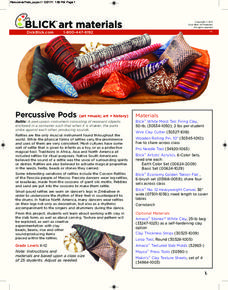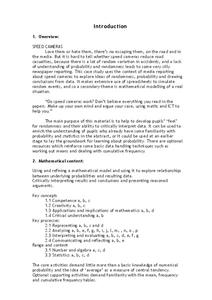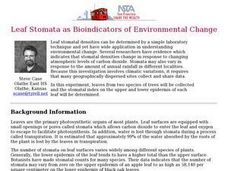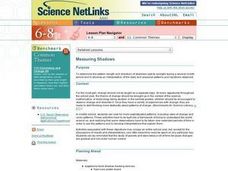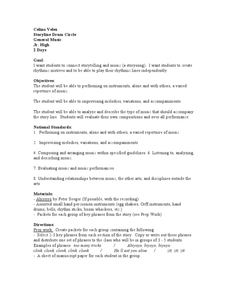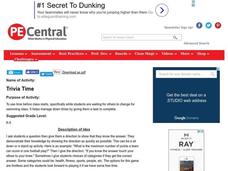Western Kentucky University
Understanding Genetics: Punnett Squares
Can scientists really predict genetic outcomes or are they simply making a lucky guess? Scholars first learn about Gregor Mendel and how to make Punnett squares. Then they extract DNA from a strawberry in a lab with included conclusion...
Novelinks
Walk Two Moons: List-Group-Label
Use a vocabulary asssignment as a quick activity between reading chapters of Walk Two Moons by Sharon Creech. Young readers choose their favorite words from the vocabulary word list to describe Sal, Phoebe, or any other character from...
Workforce Solutions
Workplace Personalities
Being able to get along with a variety of personalities in the workplace is a key job skill. To gain insight into the importance of this skill, class members take on roles of various personality types and work in groups to try to build a...
Teach Engineering
May the Force Be With You: Lift
Get the class up and going with a lesson that discusses how airplane wings provide lift. Pupils use their knowledge of Bernoulli's Principle to develop an explanation of how it creates lift on airplane wings.
Virginia Polytechnic Institute and State University
Lesson Plan: Successful Microwave Cooking
No need to be involved in a home economics or cooking courses to take advantage of this resource. Not only is there an explanation for how microwaves work but there are also tips for how to use the microwave, and cautions for what not to...
Dick Blick Art Materials
Percussive Pods
Combine the study of art, music, and history with an activity that asks kids to craft rattles out of slabs of clay.
Gatton Park
Magical Maths
A variety of activities take scholars outside the classroom to explore shapes, symmetry, measurement, patterns, sorting, and time in nature. Learners participate individually, and in teams, to measure found objects, go on a scavenger...
Smithsonian Institution
The Sounds of an Island: Jamaican Music for the Classroom
Introduce young explorers to the music and history of Jamaican culture through game songs and dances. As a bonus, class members get to play simple songs transcribed for the recorder.
EngageNY
How Do Dilations Map Lines, Rays, and Circles?
Applying a learned technique to a new type of problem is an important skill in mathematics. The lesson asks scholars to apply their understanding to analyze dilations of different figures. They make conjectures and conclusions to...
TryEngineering
Search Engines
Introduce search engines with an activity that models how search engines work and the different algorithms they employ. Working in groups, class members then build search queries to demonstrate the knowledge learned.
National Park Service
Hibernation-Migration-Fascination
What's the difference between hibernation and a good nap? Find out with an engaging life science activity that compares the hibernation habits of grizzly bears and marmots. After learners read an informational passage about each mammal,...
Bowland
Speed Cameras
Do speed cameras help reduce accidents? Scholars investigate this question using a series of spreadsheet activities. Along the way, they learn about randomness, probability, and statistical analysis.
Chicago Botanic Garden
Leaf Litter Ecology Lab
Some organisms spend their entire lives in leaf litter. The third in a series of six is a great lesson exploring the community of leaf litter. Groups gather and then spread leaf litter over white paper and remove leaves/twigs while...
Serendip
Vitamins and Health – Why Experts Disagree
Should people take vitamins or get the needed minerals through diet? Experts disagree based on many different factors. Scholars compare study findings and discuss the differences. They learn the importance of comparing results across...
Curated OER
Leaf Stomata as Bioindicators of Environmental Change
Students perform an experiment to determine the stomaltal index on the upper and lower epidermis of two species of leaves. Stomatal densities change in response to changing atmospheric levels of carbon dioxide and to annual rainfall.
Curated OER
Rethinking Time, Age, And the Calendar
Students creat personal timelines, marking key events in their lives. They discuss the different events with a small group. They analyze how Western Civilization influenced their timeline in comparison to Eastern Asia.
Curated OER
Animal Parts
In this animal body parts worksheet, students play a matching game where they match 16 different animal part cards with the corresponding animals provided on a list. Picture and word cards are provided. Directions for introducing the...
Curated OER
Dancing Number Sentences
Students explore how dance can be infused with mathematics. In this art and mathematics lesson, students recognize how the ABA dance form is similar to a math number sentence. Students create a dance choosing dance words to represent...
Curated OER
HULA HOOP MATH
Students move about the area doing the locomotor action the teacher directs them to do. When the music stops I hold up a card with the problem for all to see. They come up with an answer they form into a group in a hoop with the number...
Curated OER
Measuring Shadows
Students determine the pattern (length and direction) of shadows cast by sunlight during several month period, and develop interpretation of daily and seasonal patterns and variations observed.
Curated OER
Hockey in the Middle
Students participate in passing a puck and receiving a pass. In this hockey lesson, students are divided into small groups and practice passing a puck in different directions. The lesson is based on the game of "Monkey in the Middle".
Curated OER
Storyline Drum Circle
Students perform story songs. In this rhythmic motives lesson, students practice melodies, variations, and accompaniments as they read Peter Seeger's Abiyoyo and create compositions to present it as a story-song.
Curated OER
Trivia Time
Learners participate in a trivia game and follow directions during a down time.
Curated OER
Introduction To Natural Selection
Seventh graders investigate the concept of natural selection and it relation to the theory of evolution. They create a definition for classification based upon looking at other subjects that are similar. The variation of species is...
Other popular searches
- Direct Variation in Algebra
- Direct Variation in Graphs
- Direct Variation in Math
- Direct Variation and Graphs
- Direct Variation Activities
- Direct Variation Algebra
- Inverse and Direct Variation
- Direct Variation + Algebra
- Inverse & Direct Variation
- Slope and Direct Variations
- Direct Variation Basketball
- "Direct Variation" + Algebra







